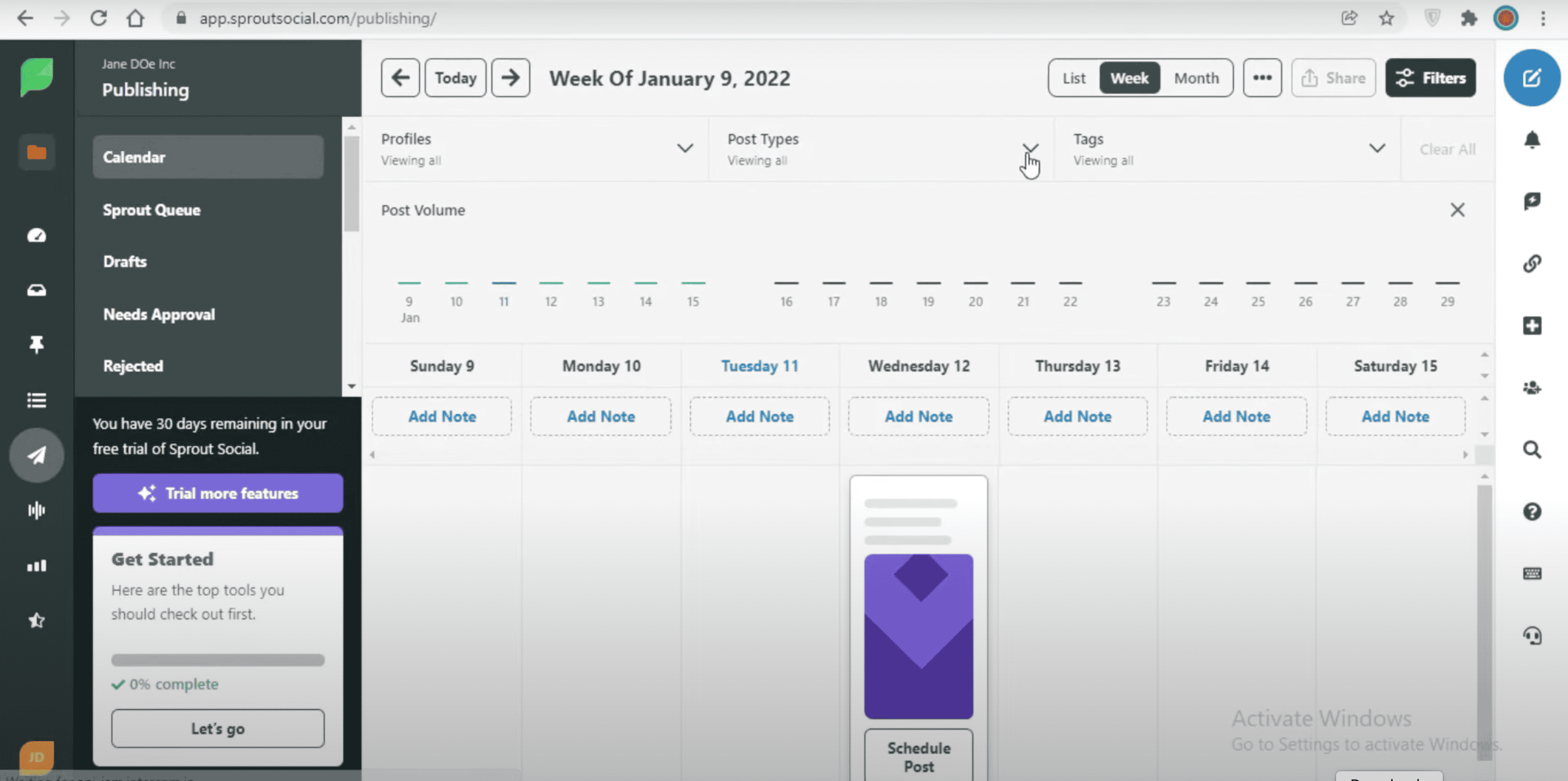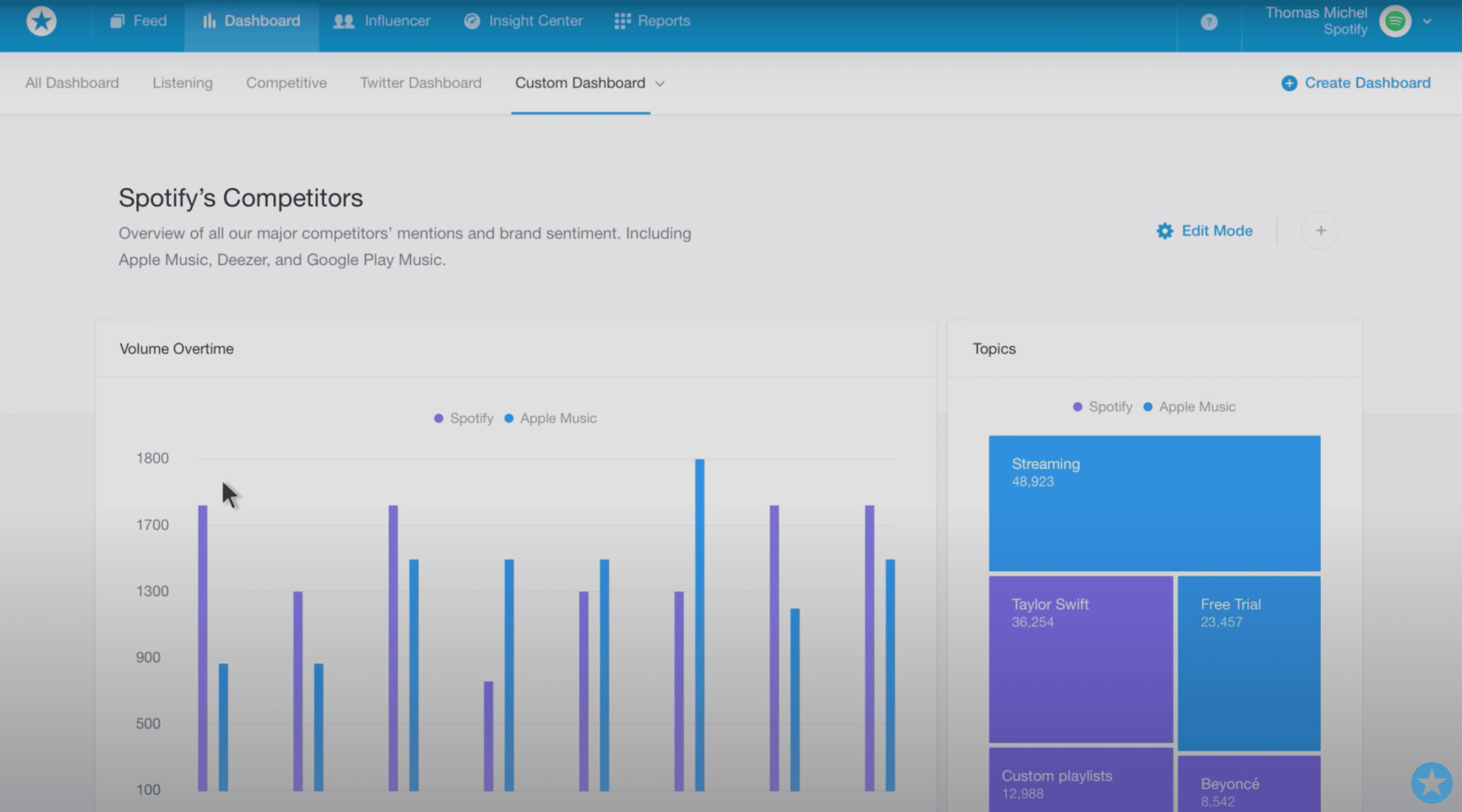Top 8 Competitor Monitoring Tools (+ What They're Best At)
By Emily Fenton
Updated December 10, 2024

What is Competitor Monitoring
Competitor monitoring refers to researching your competitors to develop an ongoing understanding of their activities strategies – such as with their pricing model, products, new launches and marketing tactics.
Meanwhile, through market research, you can also dig deeper into industry trends, your ICP, customer behaviours, and potential market opportunities.
Why is Competitor Monitoring Important
It isn't enough to just have a vague sense of your competitors' brand and products. Competitor monitoring is the first step to developing a competitive intelligence strategy, which Klue defines as "the process of legally gathering, analyzing, and leveraging information about your market, competitors, and buyers to improve your performance and market position."
A strong strategy requires keeping a close eye on more specific competitor updates, often originating from competitor websites. According to Crayon's 2021 State of Competitive Intelligence Report, 99% of survey respondents found value in monitoring competitor website changes.
Such competitor updates, often originating from their websites, can include:
- Product launches
- Price changes
- Deals and promotions
- Marketing campaigns
- SEO
- Customer reviews
- Social media
- Executive team pages
- Job postings
- News and press releases
By monitoring these changes on an ongoing basis, you can analyze them for insights and meaning that apply to your own company. This process provides the foundation for an ongoing competitor strategy you can use to enable revenue teams to better convert leads.
Key Benefits of Competitor Monitoring Tools
Save Time, While Staying in the Know
Competitor monitoring tools automate the tedious research that goes behind catching and recording updates from competitors. This gives you more time to analyze the updates for insights, and communicate it to stakeholders.
Track More Granular Competitor Updates
The right tool can enable you to track the precise competitor moves you need to enable revenue teams to better nurture leads and drive conversions.

Stay Ahead of the Curve
By automating your competitor monitoring, you can pick up on signal much faster, than if you were manually looking up these changes yourself. Pick up on the early indications of competitor activity, such as an upcoming product launch or rebranding campaign – before it’s officially announced in an email blast or social media post.
By spotting competitor moves and market trends before they hit the mainstream, you can adapt quickly and stay relevant.
Here are the top 8 competitor monitoring tools for 2025.
Top Competitor Monitoring Tools 2025
Visualping
- Pricing: Low
- Monitoring versatility: High
- Ease of use: High
Visualping is an easy-to-use AI competitor monitoring tool that lets you track any web pages, on the internet, for the exact updates you care about.

It includes AI-generated competitor summaries, so you understand updates quickly. Its AI will also detect whether a given change is deemed important or not, according to your custom criteria. This is so that you'll know, right away, whether an update is worth your attention.
Best for
- Marketers, sales teams and product specialists, from small to large enterprises, looking for an affordable and highly customizable monitoring tool to track specific topics of interest - such as competitor price tracking, and tracking competitor website changes.
Pricing
Free trial available? Yes, for 14 days.
-
One of the most affordable competitor monitoring tool available: Business plans start at $100/month, which includes +20 business-only features, including AI summaries, team collaboration features, advanced reporting and integrations with Google Sheets.
-
Book a demo here to see how Visualping can help with your competitor monitoring.
Top Features
- Because it's a website change monitoring tool, you can monitor any web pages on the internet. Get notified on the exact updates you're after, regardless of how specific and granular.

-
Real-time change alerts, that include AI summaries and analysis of the change, as well as a visual screenshot, so you understand the update quickly.
-
Advanced customization, including AI analysis, keyword alerts and custom reporting, allowing you to identify when something’s important and save time processing alerts.
Drawbacks
In terms of archiving competitor updates, you can only store data for one year.
Kompyte
- Pricing: High
- Monitoring versatility: Moderate
- Ease of use: Low to Moderate
Kompyte is an “all-in-one” competitive intelligence platform that curates competitor updates for you, from a mix of predetermined sources, into a feed, and then allows you to build and share battlecards to enable your sales team.

Best for:
- Competitive intelligence specialists and product marketing managers, from large enterprises with a budget, focussing on sales enablement.
Pricing:
Free trial available? No.
- Essential: starts at $400/month, with an additional $8/user and $80/competitor.
- Professional: $2900/month
- Unlimited: $4800/month
Top Features
-
Competitor content curation: tracks competitor updates across websites, social media, and job postings, and curates it into a feed.
-
Battlecards: turn competitor updates into insights, and then map your positioning, for a given competitor, one each battlecard. The templates are customizable, and you can continuously update them, over time, as your positioning changes.
-
Integrations with sales tools: Battlecards are directly integrated into CRM systems, making it easy for sales to leverage your insights and positioning during demos and deals. In turn, you get internal competitive intelligence data, including sales performance and battlecards views, to optimize your enablement plan.
Drawbacks
The focus for Kompyte, similar to other competitive intelligence platforms, like Klue and Crayon, is sales enablement. Kompyte’s content curation is designed for more broad, high-level surveying of the competitor landscape, as opposed to tracking specific competitor updates and activities that may be of interest for a given project or initiative.
In addition, the emphasis on battlecards may not address the competitor monitoring needs of other teams, such as product, marketing or customer service, who may require more granular and nuanced competitor insights.
SproutSocial
- Pricing: High
- Monitoring versatility: Low
- Ease of use: Moderate
SproutSocial is a social media management and intelligence platform for better understanding your competitors' social media performance, so you can optimize yours accordingly.

Best for:
- Best for midsize to large enterprises and agencies, with a sizable social media budget.
Pricing:
Free trial available? Yes, for 30 days.
- Standard: $199/month
- Professional: $299/month
- Advanced: $399/month
- Enterprise: Custom. You have to contact sales.
Top Features
-
Competitive reports: for each social media platform, you can view metrics for post performance, audience growth, impressions and more.
-
A Premium Analytics tool that offers deeper insights into your social platforms, along with interactive charts and graphs that you can customize to align with your goals. You can also easily export your reports in CSV and PDF, for sharing your results with stakeholders.
-
Advanced social listening: set up views to monitor published content, for specific keywords and hashtags, across different social media platforms. Efficiently gauge consumer sentiment for you and your competitors’ products, and assess your share of voice in the industry.
Drawbacks
It’s one of the more expensive social media platforms available.
Additionally, social media is a major source of competitive intelligence, but monitoring one channel, alone, limits your strategy. Your competitors have websites, homepages, products, organic blog content, pricing, etc, that can tell you a lot about their positioning, marketing tactics, upcoming plans, etc.
Social media only tells you what your competitors want you to know, when they want you to know it. To venture beyond social media, you’ll need to incorporate additional competitor monitoring tools into your arsenal.
AlphaSense
- Pricing: High
- Monitoring versatility: Moderate
- Ease of use: Low
AlphaSense is a comprehensive, AI-powered market intelligence platform for corporate and financial professionals. It’s a research-intensive database tool.

Best for
- Investment firms, financial services firms, corporations or consulting companies, looking for a high-level market and competitor research solution.
Pricing
Free trial available? Yes, for 14 days.
- Approximately 20k/year, but pricing is tailored to your use case and needs.
Top Features
-
Breadth of content: Access to 10,000+ public, private, proprietary, and premium data sources.
-
Premium content sources: Includes broker research (including content you can purchase, Wall Street Insights®, for corporate clients), Expert Insights, trade journals, news, SEC filings, global filings, and more.
-
AI Search & Summaries: The content in your feed is prioritized by relevance, and you can get quick AI-powered summaries on longer documents and reports.
Drawbacks
AlphaSense is more for financial teams, conducting market research for investment management. Even if your focus is competitor monitoring, you can only search up information on publicly traded companies – private companies are off the table.
The types of web sources you can track are also limited. You get extensive coverage on internal and external documents, like press releases, financial data and reports – but you don’t have the option to take a closer look at more specific, granular web sources, like your competitors’ latest promotions, job openings, executive hires, blog content, etc.
Depending on your goals, AlphaSense may not offer the flexibility your competitor monitoring initiative requires.
Mention
- Pricing: Low to moderate
- Monitoring versatility: Moderate
- Ease of use: High
Mention is a simple and affordable media monitoring and social listening tool. It crawls over a billion sources on the web, including news sites, forums, review sites and websites, and notifies you when a certain topic, like you, or your competitors’, brand name gets mentioned. You can track specific keywords, hashtags, brand mentions, or topics of interest. Mention also monitors social media platforms, like LinkedIn, Twitter, Facebook and TikTok.

Best for
-
SMBs and Enterprises tracking specific keywords of interest, from literally anywhere on the web (rather than focussing on a bundle of target web pages)
-
Best for reputation monitoring (knowing what's being said about you, or your competitors’, brand), and competitor monitoring (monitoring your competitors to understand shifts in their strategies, and positioning your brand accordingly).
Pricing
Free trial available? Yes, for 14 days.
- Solo: $49/month
- Pro: $99/month
- ProPlus: $179/month
- CompanyPlan: Contact their sales team.
Top Features
-
Real-time notifications: You can stay up-to-date on conversations, as they happen, either in your live feed, or through email alerts.
-
Social media analytics: You can track the performance of your social media campaigns, the conversation volume, and your brand’s share of the mentions. You get a dashboard that includes quick visualizations of your success. You can also build custom reports to share with stakeholders.
-
Influencer Identification: you get visibility into who’s talking about your brand, and how their influence ranks across communities. . By identifying your top influencers, you’ll know who to reach out to for collaboration efforts.
Drawbacks
Depending on how precise you are in defining your alerts and keywords, you may have to sift through a lot of noise in your live feed or inbox. Just because your brand, or a competitors’ brand, gets mentioned somewhere on the web, doesn't mean it’s a particularly relevant and or useful update. Unless you’re tracking topics and keywords niche to your product or industry, you may be spending a lot of time deciphering what’s important or not.
SemRush
- Pricing: High
- Monitoring versatility: Moderate
- Ease of use: Moderate
SemRush is one of the top SEO tools for competitor keyword and backlinks research, PPC, and social media marketing on a single, integrated platform.

Best for:
- Digital marketing teams, content creators, and SEO professionals looking for a comprehensive SEO tool to benchmark their competitors’ SEO to their own, and improve their search visibility and organic traffic.
Pricing:
Free trial available? Yes, for 7 days.
- Pro Plan: for freelancers, startups, and in-house marketers on a budget. $119.95 per month.
- Guru Plan: for small-to-medium businesses, and growing marketing agencies. $229.95 per month.
- Business Plan: for agencies, and businesses with extensive web presence. $449.95 per month.
Top Features
-
SEO and Technical Audits: Various functionalities for keyword research, backlink analysis, and technical SEO audits.
-
Market Research: Provides insights into competitors’ strategies, market trends, and audience preferences to help users gain competitive advantages
-
PPC Optimization: Tools enhance your PPC management, from keyword research to competitor ad monitoring.
Drawbacks
SemRush is solely an SEO tool. It doesn’t provide competitor data on marketing channels outside of the search results. While pumping up your search visibility and organic traffic is a great way to establish your brand presence, pull in leads and compete with competitors, your competitor monitoring shouldn’t be limited to SEO and search results.
SimilarWeb
- Pricing: High
- Monitoring versatility: Moderate
- Ease of use: Moderate
SimilarWeb provides insights into competitors’ web and app performance. You can better understand their competitors’ website traffic and market trends, across numerous industries, and then optimize their digital strategies based on real-world data.

Best for
- Digital marketers, market researchers or business strategists, aiming to better gauge market shifts and a higher-level view of the competitive landscape.
Pricing
Free trial available? Yes, for 7 days.
- Starter: Billed yearly, $125 per month, or $149, monthly.
- Professional: Billed yearly, $333 per month, or $399, monthly.
- Team: Custom pricing, contact their sales team.
- Enterprise: Custom pricing, contact their sales team.
Top Features
-
Website and App Analysis: extensive analysis for monitoring traffic, engagement metrics, and growth trends across competitors’ websites and mobile apps.
-
Digital Research and Benchmarking: in-depth industry and competitor analysis to help you benchmark your performance against competitors, and the industry standard.
-
Audience Insights: detailed insights into audience demographics, interests, and behavior, helping you tailor your marketing and product development accordingly.
Drawbacks
SimilarWeb is also primarily a web listening tool. While it offers a broad scope of data, the granularity of data varies. Niche markets, or smaller geographic regions, have less detailed coverage. Nor does it offer ongoing competitor updates for more granular activity, like price changes or product launches.
Feedly
- Pricing: Moderate
- Monitoring versatility: Low
- Ease of use: High
Feedly is probably the most popular content aggregator and RSS reader on the web. Feedly curates content from the web, including news sites, blogs, Twitter, Reddit, and newsletters. It includes Leo, an AI-powered research assistant that helps you find, prioritize, and summarize articles for you, according to your interests.

Best for
-
Market intelligence professionals, looking for a more structured way to review news and blog content they’re interested in.
-
Personal use, for anyone curious about particular topics, and want to stay organized (there’s a separate pricing structure that’s significantly lower than the above)
Pricing
Free trial available? Yes, for 30 days.
- Starter: $1,200/month
- Basic: $2400/month
Top Features
-
Evernote integration: you can save articles you care about, and want to take a closer look at, in Evernote.
-
Leo, the AI search assistant: Leo helps filter your feeds and surface the content you really want, which you can save to your boards to collaborate with your team, or just take a closer look at later.
-
iOS and Android apps, as well as the web interface.
Drawbacks
Feedly is a good way to get a good sense of a certain topic or industry, and to keep tabs on content your competitors are publishing on their website, blog or social media. However, your competitor monitoring is limited to news, blogs and social media content. There is also little functionality for tailoring your feeds to specific content of interest – you will be spending time sifting through a fair amount of content to assess what matters to you and your project.
How to Pick the Right Competitor Monitoring Tool
No single competitor monitoring tool will work for everyone. Different teams have different goals, scopes and budgets, and it depends on the type of competitor data your competitive intelligence strategy requires.
For many, tracking competitors means zooming in on particular topics of interest, such as their press releases, or newest job postings. Opting for a feature-dense, "all-in-one" competitive intelligence tool, with additional analysis features and sales enablement capabilities, may not be necessary - especially given the price tag for this kind of software.
Or, rather, if you're a competitive intelligence specialist at a bigger company, with a bigger budget, then you may be after a more high-level view of the competitor landscape. Some tools curate data into a feed, for a more macro view of what's happening with your competitors.
Different competitor monitoring tools track different kinds of data. Evaluate your options according to your team’s strategy, and the flexibility your monitoring objective requires.
Try Visualping for Free
The bottom line? Some competitive intelligence tools are more affordable, versatile and easy-to-use than others. When picking the tool for you, prioritize the scope of data your strategy needs.
Visualping allows your business to stay up-to-date on key competitor activity, from anywhere on the web. It combines affordability and versatility, making your competitor monitoring process specific to your team’s projects and areas of interest, without the dense over-functionality and massive subscription fees.
Interested in finding out more? Book a demo today - we’d be happy to tailor Visualping to your needs.
Visualping: competitor monitoring made simple
Get targeted updates from the competition on autopilot. Trusted by 85% of Fortune 500 companies.
Emily Fenton
Emily is the Product Marketing Manager at Visualping. She has a degree in English Literature and a Masters in Management. When she’s not researching and writing about all things Visualping, she loves exploring new restaurants, playing guitar and petting her cats.